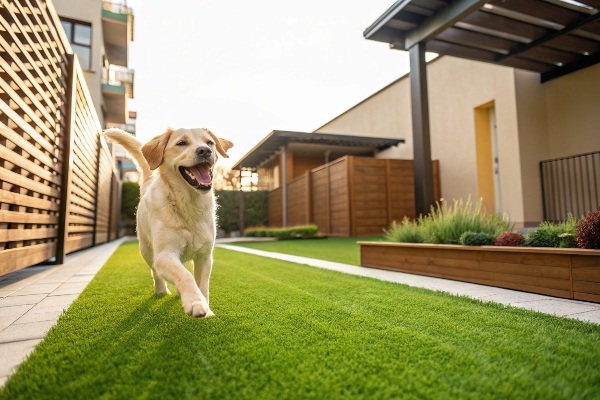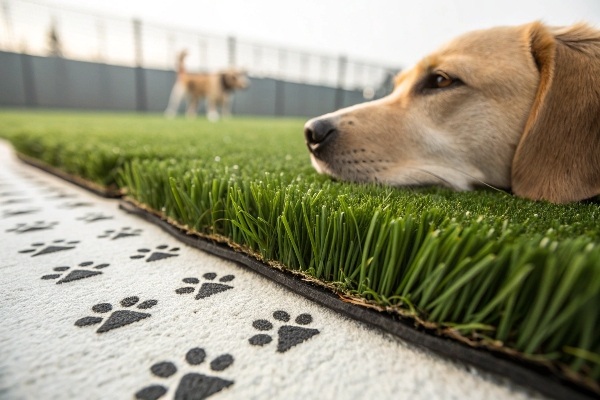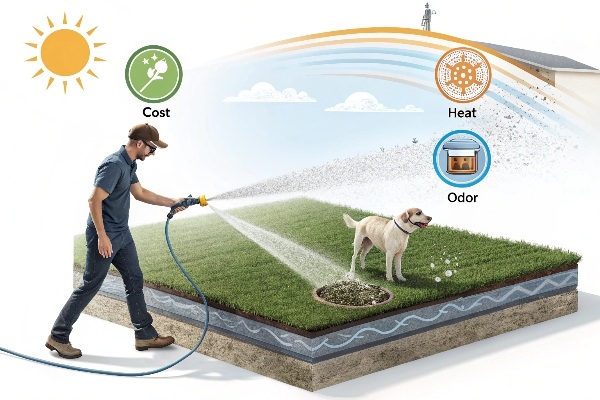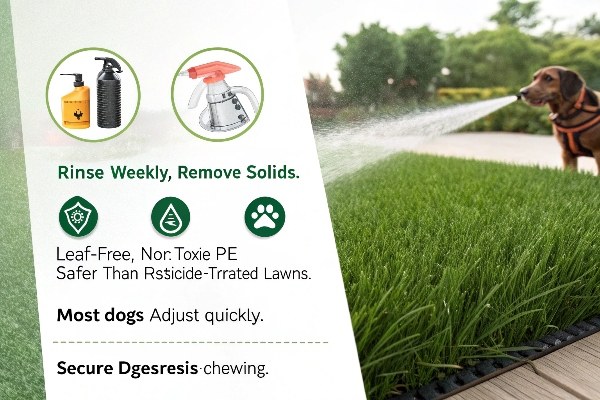Tired of muddy paws and dead lawn patches? Artificial grass promises a perfect yard, but you need the full story before deciding if it’s right for you and your dog.
The main benefits of artificial grass for dogs are durability, cleanliness, and very low maintenance. The primary downsides are the high initial cost, potential for heat retention in direct sun, and possible odors if not cleaned properly. A quality installation is key to minimizing the cons.

Making the switch from a natural lawn is a big decision. You love your dog, but you also want a yard that looks good and doesn’t create extra work. Many dog owners I’ve worked with face this same challenge. They want a solution that works for their entire family, including the furry members. Below, I’ll break down the real advantages and disadvantages I’ve seen over my years in the industry. This will help you make a choice you won’t regret.
What are the advantages of artificial turf for dogs?
You are tired of constant mowing, watering, and fertilizing. You also worry about your dog digging up the lawn or getting exposed to harmful lawn chemicals from a natural lawn.
Artificial grass is extremely durable against digging and heavy play. It stays green year-round without pesticides, and it keeps both your dog and your home much cleaner by eliminating mud.

When I first started as an engineer, I was amazed at how tough we could make artificial turf. For dog owners, this is a game-changer. The biggest advantage is durability. Dogs can run, jump, and dig all they want, but a well-installed turf system will stand up to the abuse without creating bare spots or holes. Another major benefit is cleanliness. I remember a client with two golden retrievers who told me the best part was no more muddy paws being tracked through his house after it rained. Because artificial grass has excellent drainage, urine passes right through, and solid waste can be picked up easily from the surface without leaving a mess. This leads to the third advantage: it’s a safer, low-maintenance space for your pet. You no longer need fertilizers, pesticides, or weed killers, many of which can be toxic to dogs.
| Feature | Natural Grass Lawn | Pet-Friendly Artificial Turf |
|---|---|---|
| Durability | Wears down with heavy use, prone to digging | Highly durable, resists digging and high traffic |
| Cleanliness | Creates mud, grass stains | No mud, easy to clean waste |
| Maintenance | Mowing, watering, fertilizing | Rinsing, brushing, removing solid waste |
| Safety | May require pesticides/fertilizers | No harmful chemicals needed |
| Appearance | Prone to yellow spots from urine, bare patches | Stays green and even year-round |
What are the disadvantages of artificial turf for dogs?
You have heard artificial grass is a perfect solution, but you are skeptical. You worry it might get too hot, smell bad, or feel unnatural for your pet.
The main drawbacks are the high upfront installation cost. The surface can also get very hot in direct sunlight, and if not installed and cleaned properly, it can trap odors from pet urine.

It’s important to be honest about the potential downsides. I always tell my clients that while artificial grass is great, it’s not magic. The first thing to consider is the initial cost. Professional installation is an investment, significantly more than laying down natural sod. You have to weigh this upfront cost against the long-term savings on water bills and lawn care. The second major concern, especially in hot climates, is heat retention. The plastic blades can get much hotter than natural grass in direct summer sun. However, this can be managed by choosing lighter-colored grass, using a cooling infill, or simply hosing the area down for a few seconds before letting your dog out to play. The final issue is odor. If urine is not rinsed away and the system doesn’t have proper drainage, ammonia can build up and cause smells. This is why a professional installation with the right materials is not just a recommendation—it’s essential for pet owners.
| Potential Problem | How to Solve It |
|---|---|
| High Initial Cost | View it as a long-term investment that saves on water, fertilizer, and maintenance over time. |
| Heat Retention | Choose turf with heat-reduction technology, use a cooling infill like zeolite, and rinse with a hose on hot days. |
| Odor Buildup | Ensure professional installation with a fully permeable sub-base. Rinse regularly and use an odor-neutralizing infill. |
| Unnatural Feel | Most dogs adapt quickly. You can introduce them to it slowly and make it a fun space with toys. |
How do you choose pet-friendly artificial grass?
Not all artificial grass is the same, especially for pets. Choosing the wrong type could lead to drainage issues, trapped odors, or a surface that falls apart under heavy use.
Look for three key features. First, choose a product with a fully permeable backing for superior drainage. Second, select a shorter, durable pile height. Third, use a pet-friendly, non-toxic infill to control odors.

Over the years, I’ve seen exactly what works and what doesn’t for pet applications. The success of your artificial lawn depends heavily on choosing the right components. Don’t let a salesperson tell you any turf will do. You need a system designed for pets.
The Importance of Backing
The backing is the foundation of the turf system. Many standard products use a hole-punched backing, where small holes are punched to let water through. The problem is that urine can get trapped on the backing material between the holes, leading to bacteria and odor buildup. For dogs, you must insist on a 100% permeable or non-perforated backing. This material allows liquid to pass through any part of the surface, ensuring urine drains away quickly and completely.
Pile Height and Density
While long, lush grass looks beautiful, it’s not practical for dogs. A shorter pile height, typically around 1.0 to 1.5 inches (25-38mm), is much easier to clean. Solid waste sits on top of the fibers instead of sinking in, making pickup simple. A dense pile is also more resilient and will stand up better to constant running and playing.
The Right Infill
Infill is the material spread between the grass blades. It provides stability, cushion, and helps the blades stand up. For pets, the type of infill is critical. Avoid crumb rubber, as it can get very hot and hold odors. I strongly recommend Zeolite infill. Zeolite is a natural mineral that absorbs the ammonia in urine, effectively trapping odors before they become a problem. When it rains or you rinse the lawn, the water releases the ammonia and flushes it away.
What are the most frequently asked questions about artificial grass for dogs?
You still have specific questions before making a final decision. There is a lot of information out there, and it can be confusing to know what to believe for your dog’s safety.
Owners ask about cleaning, safety, and if dogs like it. You clean it by rinsing with a hose and removing solid waste. It is safe if lead-free. Most dogs adjust quickly and love it.

After helping hundreds of customers, I’ve found that the same few questions always come up. It’s smart to ask them, as the answers are key to feeling confident in your decision. Let’s cover them one by one based on my experience.
How do you clean dog pee off artificial grass?
This is the most common question. For the most part, you don’t have to do much. A proper drainage system will carry most of the urine away. I recommend a quick rinse with a garden hose once or twice a week in areas your dog uses frequently. For stubborn smells or a deep clean, you can use a simple mixture of water and white vinegar or a professional enzyme cleaner designed for artificial turf. The key is consistent, light maintenance.
Is artificial turf actually safe for dogs?
Yes, provided you buy a quality product. Reputable manufacturers like us ensure our turf is made from non-toxic polyethylene and is completely lead-free. In fact, it can be safer than a natural lawn because it eliminates your dog’s exposure to potentially harmful fertilizers, pesticides, and weed killers.
Will my dog try to eat or destroy the turf?
It’s very rare. Most dogs might chew on it out of curiosity at first, but they quickly realize it’s not very interesting. A professional installation is also crucial here. When the edges are properly secured, there are no loose ends for a dog to grab and pull on.
How well does artificial grass drain water and urine?
Modern pet turf systems are designed for maximum drainage. The system isn’t just the grass itself; it’s the entire profile. Under the turf, we install a sub-base of crushed rock that acts like a large drain field. The turf’s permeable backing and this sub-base work together to drain liquids away much faster than typical soil, preventing puddles and sogginess.
Conclusion
Choosing artificial grass for your dog offers great benefits like cleanliness and durability but requires correct installation and maintenance to manage heat and odors. It is a worthy long-term investment.
_画板-1.png)
_画板-1.png)